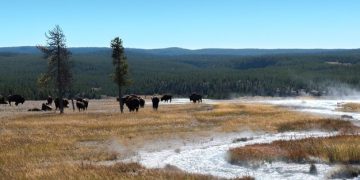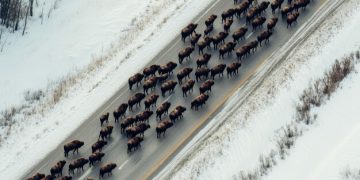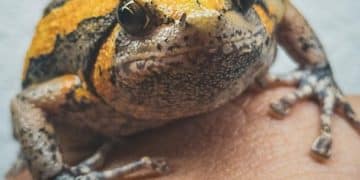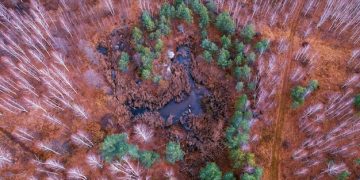Support Wildlife: How Your Donations Protect US Animals

Supporting wildlife conservation organizations through donations is crucial for protecting US animals by funding essential conservation efforts, habitat preservation, and research initiatives.
The diverse wildlife of the United States faces numerous threats, making conservation efforts more critical than ever. Supporting wildlife conservation organizations is a tangible way to contribute to the preservation of these species and their habitats. Discover how your donations can make a significant impact.
Why Support Wildlife Conservation?
Wildlife conservation is essential for maintaining the ecological balance, biodiversity, and overall health of our planet. Many US animal species face threats such as habitat loss, climate change, poaching, and pollution.
By supporting conservation organizations, you directly contribute to mitigating these threats and ensuring the survival of these animals for future generations.
The Importance of Biodiversity
Biodiversity refers to the variety of life on Earth, including the diversity of species, their genetic variations, and the ecosystems they form. A rich biodiversity is crucial for ecosystem stability and resilience.
- Maintaining ecosystem balance.
- Ensuring genetic diversity within species.
- Supporting food security and human health.
Threats to US Wildlife
Understanding the specific threats that US wildlife face is crucial for effective conservation. These threats can be broadly categorized into habitat destruction, climate change, and direct exploitation.
Habitat destruction, primarily driven by urbanization and agriculture, significantly reduces the living spaces for many species.
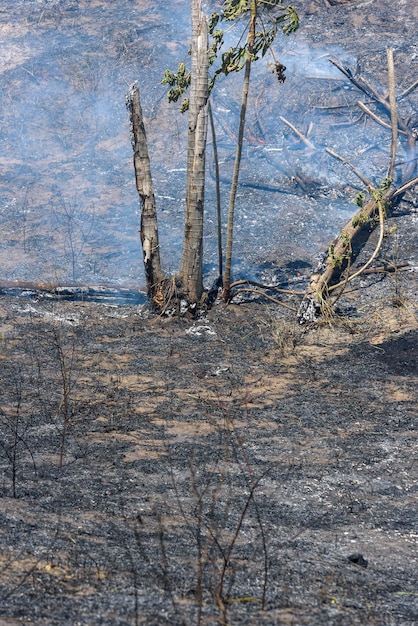
- Habitat Loss and Fragmentation
- Climate Change
- Poaching and Illegal Wildlife Trade
Climate change is altering ecosystems, causing shifts in species distribution, and increasing the frequency of extreme weather events that impact wildlife populations.
In conclusion, supporting wildlife conservation is vital due to the increasing threats of habitat loss, urbanization, and climate change. These efforts help maintain biodiversity and protect vulnerable species, ensuring healthy ecosystems for future generations.
Key Wildlife Conservation Organizations in the US
Several organizations are dedicated to protecting wildlife in the United States. Each organization has its unique focus and approach, but all share the common goal of conserving wildlife and their habitats.
When choosing an organization to support, consider their mission, effectiveness, and transparency. Researching their past projects and financial reports can help you make an informed decision.
National Wildlife Federation
The National Wildlife Federation (NWF) works to protect wildlife and habitats across the United States. They focus on issues such as climate change, habitat conservation, and sustainable resource management.
The NWF also engages in education and advocacy to promote wildlife conservation at the local, state, and federal levels.
- Habitat Restoration Projects
- Advocacy for Wildlife-Friendly Legislation
- Educational Programs for Communities
The Nature Conservancy
The Nature Conservancy is a global organization that focuses on conserving lands and waters. In the US, they manage numerous preserves and work with local communities to protect critical habitats.
The Nature Conservancy uses a science-based approach to identify conservation priorities and develop effective strategies.
- Land Acquisition and Management
- Restoring Coastal Habitats
- Promoting Sustainable Agriculture
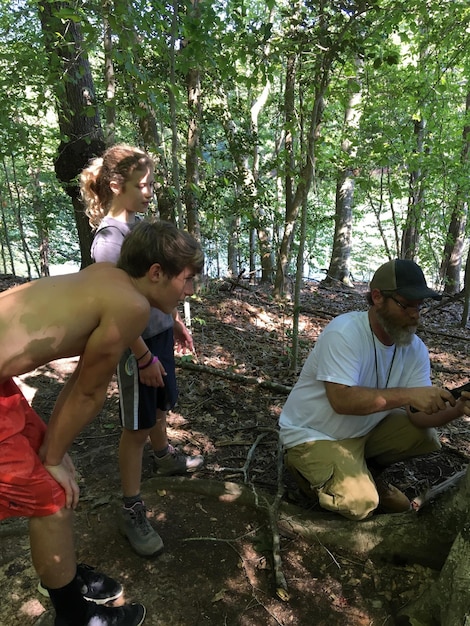
World Wildlife Fund (WWF)
The World Wildlife Fund (WWF) is a global organization with a significant presence in the United States. They focus on protecting endangered species and conserving their habitats.
WWF also works to reduce the impact of human activities on wildlife populations, such as promoting sustainable fishing practices.
- Endangered Species Protection Programs
- Combating Wildlife Crime
- Promoting Sustainable Resource Use
In conclusion, various impactful organizations like the National Wildlife Federation, The Nature Conservancy, and World Wildlife Fund are dedicated to wildlife conservation in the U.S. By supporting these organizations, individuals can contribute to habitat restoration, legislative advocacy, and endangered species protection.
How Your Donations Make a Difference
Your donations, no matter the size, can have a significant impact on wildlife conservation efforts. These funds are used for a variety of essential activities, from habitat restoration to scientific research.
Understanding how these donations are utilized can help you appreciate the value of your contribution.
Habitat Restoration
Habitat restoration involves restoring and improving degraded or destroyed habitats. This can include planting native vegetation, removing invasive species, and restoring water flow in wetlands.
These activities provide essential resources and shelter for wildlife, helping them to thrive.
Supporting Scientific Research
Scientific research is crucial for understanding wildlife populations, their behaviors, and the threats they face. This research informs conservation strategies and helps organizations make informed decisions.
Your donations can support research projects that monitor wildlife populations, study their genetic diversity, and assess the impact of climate change.
Funding Conservation Initiatives
Conservation initiatives encompass a wide range of activities aimed at protecting wildlife and their habitats. These can include establishing protected areas, managing wildlife populations, and educating the public about conservation.
Your donations can directly fund these initiatives, ensuring that conservation efforts are effective and sustainable.
In summary, donations significantly aid habitat restoration by planting native species and controlling invasives. They also support crucial scientific research that informs conservation strategies and fund various conservation projects, ensuring effective protection and sustainability for wildlife.
The Importance of Local Conservation Efforts
While national and international organizations play a crucial role in wildlife conservation, local efforts are equally important. Local conservation organizations often have a deep understanding of the specific challenges facing wildlife in their region.
Supporting these local groups can lead to more targeted and effective conservation outcomes.
Community Engagement
Local conservation organizations excel at engaging communities in conservation efforts. They organize volunteer events, educational programs, and citizen science projects that involve local residents in protecting wildlife.
This community engagement fosters a sense of ownership and responsibility for wildlife conservation.
Regional Wildlife Protection
Regional wildlife protection involves implementing conservation strategies tailored to the specific needs of local species and ecosystems. This can include managing invasive species, restoring specific habitats, and protecting critical wildlife corridors.
Your support for local organizations ensures that these regional efforts are adequately funded and sustained.
Local initiatives are essential for raising awareness within communities.
- Conservation Education
- Volunteer Opportunities
- Citizen Science Projects
By integrating conservation into community activities, more people are likely to support wildlife protection.
In conclusion, local conservation efforts are essential for community engagement, regional wildlife protection, and raising awareness through education and volunteer opportunities. Supporting these grassroots initiatives enhances targeted conservation outcomes and fosters community responsibility for wildlife.
Ways to Donate and Get Involved
There are many ways to support wildlife conservation organizations, ranging from direct financial donations to volunteering your time and skills.
Choosing the right method can depend on your personal interests, resources, and level of commitment.
Monetary Contributions
Monetary contributions are the most direct way to support wildlife conservation organizations. These donations can be made as one-time gifts or recurring monthly donations.
Many organizations also offer the option to dedicate your donation in honor of someone or a specific cause.
Volunteer Opportunities
Volunteering your time is another valuable way to support wildlife conservation. Many organizations rely on volunteers to assist with habitat restoration, wildlife monitoring, and educational outreach.
Volunteering can be a rewarding experience that allows you to directly contribute to conservation efforts.
Advocacy and Awareness
Advocacy and awareness are crucial for promoting wildlife conservation at the political and public levels. This can include contacting elected officials, signing petitions, and sharing information on social media.
By advocating for wildlife conservation, you can help shape policies and inspire others to take action.
In conclusion, supporting wildlife conservation involves monetary contributions and volunteer opportunities. Donations directly fund habitat restoration and research, while volunteering allows hands-on participation. Advocating and raising awareness further amplify conservation efforts by influencing policy and inspiring community involvement.
Measuring the Impact of Your Support
Understanding the impact of your support can help you feel confident that your donations are making a difference. Many wildlife conservation organizations provide detailed reports on their activities and outcomes.
Tracking the use of funds and conservation successes ensures transparency and accountability.
Tracking Conservation Successes
Many organizations track the populations of threatened species. They collect data with camera traps.
- Population Increases
- Habitat Expansion
- Reduced Threats
Annual Reports
Annual reports provide a comprehensive overview of an organization’s activities, achievements, and financial performance. These reports typically include detailed information on the projects undertaken, the funds spent, and the outcomes achieved.
Reviewing annual reports can help you assess the effectiveness and transparency of the organization.
Financial Transparency
Financial transparency is essential for building trust and ensuring that donations are used responsibly. Many organizations provide detailed financial statements and audits to demonstrate their commitment to accountability.
Reviewing these financial documents can help you understand how your donations are being used and whether the organization is financially sound.
| Key Point | Brief Description |
|---|---|
| 🌱 Habitat Restoration | Restoring degraded habitats to support diverse wildlife. |
| 📚 Scientific Research | Studying wildlife populations to inform conservation strategies. |
| 📣 Advocacy Efforts | Promoting policies that protect wildlife and their habitats. |
| 🤝 Community Engagement | Involving local residents in conservation initiatives. |
Frequently Asked Questions
▼
Various organizations, including national, local, and nonprofit groups, work to protect endangered species through habitat preservation, research, and advocacy.
▼
Research organizations, check their financial transparency, and review their conservation successes. Look for groups with clear goals and measurable outcomes.
▼
Habitat restoration includes planting native vegetation, removing invasive species, and restoring water flow in wetlands to provide resources for wildlife.
▼
Community engagement fosters a sense of ownership and responsibility for conservation, increasing support and participation in local wildlife protection efforts.
▼
You can volunteer time, advocate for conservation policies, participate in citizen science projects, and raise awareness by sharing information within your community.
Conclusion
Supporting wildlife conservation organizations is a crucial investment in the future of our planet. Through your donations and involvement, you can contribute to protecting US animals and their habitats, ensuring a thriving and biodiverse ecosystem for generations to come.
